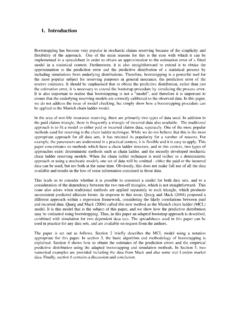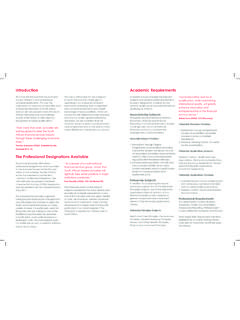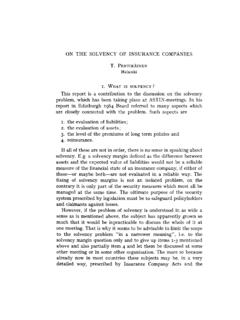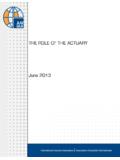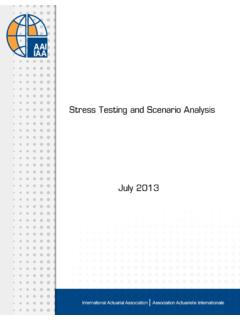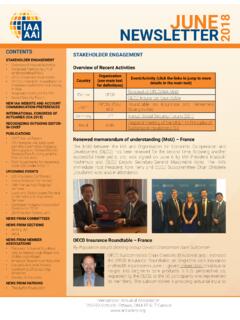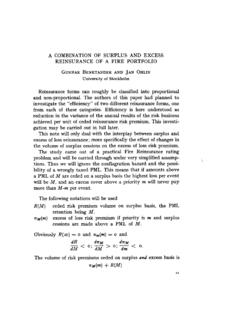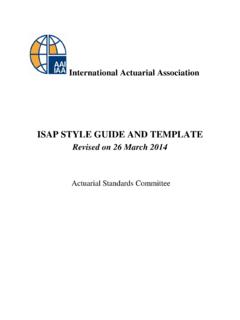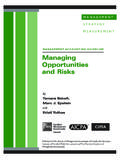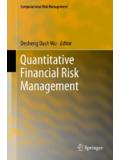Transcription of Economic Capital versus Regulatory capital for …
1 Economic Capital versus Regulatory Capital for market risk in banking and insurance sectors: Basel II experience and the challenge for Solvnecy II Marcin FEDOR Universit Paris Dauphine ABSTRACT This paper discusses market risk measurement for Regulatory Capital requirement purposes in the insurance sector. We present different aspects of market risk in the banking and insurance sectors and we discuss current Capital regulations for market risk in both financial services. Today, Regulatory approaches for setting Capital charges for market risk seem to be converging across financial sectors to the Economic Capital approach. In this context, the value at Risk (VaR) has become the standard measure to quantify market risk.
2 Although, the VaR is already widespread in banks, this method has not yet become a standard risk measurement tool in the insurance industry. Therefore, we propose necessary adaptations of VaR measure for insurance business specifications. Finally, we compare market risk estimations in insurance by four broad standardized approaches and by assessing three main VaR methods as well as judging the accuracy of all estimations by backtesting program. The article aims to contribute to the current debate concerning the development of a general framework for Capital requirements in the insurance sector, including the new EU prudential system.
3 Keywords: market risk measurement, Regulatory Capital in banking and insurance sectors, Economic Capital , value at Risk _____ Adress correspondence to Marcin Fedor: PREDICA ; 50-56, rue de la Procession; 75724 Paris Cedex 15; France; Phone: +33143236639; Fax : +33143234666; e-mail: 2 1. introduction Financial institutions activities entail a variety of risks . One of the most important category of hazard is a market risk, defined as the risk that the value of an investment may decline due to Economic changes or other events that impact market factors ( stock prices, interest rates or foreign exchange rates). Market risk is typically measured using the value at Risk (VaR) methodology.
4 In order to provide evidence of safety, firms have to maintain a minimum amount of Capital as a buffer against potential losses from their business activities, or potential market losses. The literature distinguishes Economic Capital from Regulatory Capital . The first is based on calculations that are specific to the company s risk, while Regulatory formulas are based on industry averages that may or may not be suitable to any particular company. Moreover, Economic Capital can be used for internal corporate risk management goals as well as for Regulatory purposes. This article focuses on Economic Capital estimations for market risk in two main financial institutions: banks and insurers.
5 For banks, the New Basel Accord has provided increased incentives for developing and managing their internal Capital on an Economic basis. Basel II encourages bankers to use Economic Capital for both: internal management and Regulatory Capital requirements. VaR is defined as the main tool for the calculation of market risk measurement. In the insurance sector, Regulatory Capital and Economic Capital diverge. Market risk is calculated via financial ratios integrated to Risk Based Capital formulas, moreover insurance undertakings can calculate their own market risks in internal aims. Nevertheless, VaR has not yet become a standard risk measurement tool in the insurance industry.
6 This situation will be changed in Europe in the comming years, with the introduction of the new prudential system. Solvency II will probably encourage insurers to use a one-year-VaR tool (via internal models) for Capital requirement calculations. The European debate is in progress and, today, final decisions are not yet known. The reflection on the role of market risk in the insurance sector has been dominant for a long time in other geographical zones. Many national insurance prudential systems presently include a market risk element and, for this reason, they are worthy of study. Even when they do not, as in the banking sector, enforce insurers to use VaR methodology for Regulatory Capital requirements, insurance undertakings can still use VaR tool for internal risk management purposes.
7 However, VaR models can not be used in the insurance industry without modifications and they demand necessary adoptions for business particularities. The aim of this article is to study market risk measurement in the insurance sector and its estimations for Regulatory purposes via standardized approaches and VaR methodology. As, current practices in the European Commission are in favour of using an Economic Capital calculated via VaR methodology for both internal management and Regulatory Capital purposes (so called Solvency Capital Requirements calculated by internal models), this research will compare Economic Capital calculations for market risk via VaR with existing market risk Regulatory Capital requirements (RBC formulas for market risk modules) in the biggest insurance markets.
8 Solvency II reform derives many advantages from its predecessor in the banking sector. We dispose today a good experience and fresh knowledge of Basel II Accord in the matter of risk management and control. This analyze will be thus naturally provided in comparison with Basel II amendments and solutions. 3 In spite of the large quantity of the literature concerning various aspects of the VAR, deeply studding its application in short term trading framework, we can name only a few articles treating for the VaR concept in the insurance field. Here the most important ones are: Albert at al. (1996), Ufer (1996), Panning (1999), Dowd at al. (2001) and Fedor at al.
9 (2006). The rest of this paper is organized into five sections: Section 2 introduces the VaR definition and methodology, currently in use in the banking sector. Section 3 discusses market risk concepts and its applications in the banking and insurance industries. Next, we present Capital regulations for market risk in both sectors: Economic Capital estimations via VaR methodology (introduced in banking business by Basel New Accord amendment) and four existing standardized formulas for market risk Regulatory Capital requirements in the insurance sector. In Section 4 we propose changes in VaR methodology which are necessary to adapt the concept as an internal tool for Economic Capital market risk measurement in the insurance business.
10 Section 5 empirically compares Capital charges for market risk, calculated for five sample investment portfolios, via standardized models (four RBC formulas) and VaR techniques ( Economic Capital ). The last Section concludes and gives a brief outlook for future research. 4 2. value AT RISK In this section, we briefly review the value at Risk approach, as has been traditionally used in the banking sector. First, we define VaR concept, next, we discuss VaR algorithm, finally, we describe three most popular VaR models in the banking sector. Vale at Risk definition Let htV be the future (random) value of a portfolio of financial positions at time t+h.

